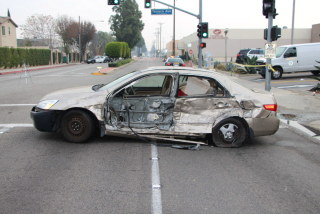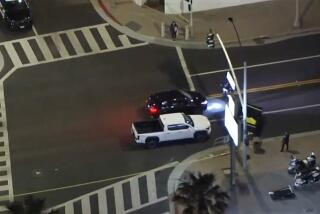For Toddlers, There’s Danger in the Driveway
- Share via
Jill Mesecher thought she and her husband Rob had done all they could to protect their precious 18-month-old daughter.
The Stevenson Ranch couple had assiduously child-proofed their home. They had bought Makena not just one but three car safety seats and made sure to buckle her in every time before getting on the road.
On a July afternoon last year, Rob Mesecher decided to back their Ford Explorer out of the driveway to make room to wash his wife’s car. He saw Makena playing near the garage door, and he shifted into reverse. When the father realized his only child had vanished from sight, he braked immediately.
It was too late. The toddler apparently ran to the moving vehicle, according to police, and her father unknowingly backed up over her, critically injuring her head.
“You can be as careful as you can possibly can be. . . . You don’t expect it to happen to you,” Jill Mesecher said recently, her husband still too distraught to discuss their daughter’s death. “Children are lightning quick.”
An increasing number of conscientious parents like the Mesechers are learning a terrible lesson: One of the most dangerous places for toddlers lies close to home, right in the family driveway.
A significant number of small children are seriously injured or killed every year by a car, truck, van or sport utility vehicle backing out of a residential driveway, studies show. Compounding the grief is that much of the time, the drivers in these accidents are the children’s parents.
“We’re all worried about getting into crashes at 60 miles an hour. But there are all these little kids getting killed in their own driveways under cars going 2 miles per hour,” said Janette E. Fennell, executive director of Kids ‘N Cars, a nonprofit organization that tracks nontraffic accidents involving children and vehicles. “This is a huge, huge problem.”
According to the National Highway Traffic Safety Administration, children ages 1 to 4 represent about 6% of the U.S. population but account for 30% of those killed in backing crashes that occur in off-road areas such as parking lots and residential driveways. An estimated 116 children in that age group die this way every year, according to a study by the agency based on data from the early 1990s. In comparison, 409 children ages 1 and 4 died in 1999 as passengers in roadway car crashes, according to the agency’s latest figures.
But because driveway deaths have not been tracked on a regular basis by federal agencies, experts believe the actual casualty rate in parking lots and driveways is much higher.
An Orange County study in the 1990s found that toddlers were more likely to be injured or killed in vehicular accidents occurring off-road than from crashes on the road.
“Young children are at greater risk in private driveways and parking lots than as occupants of motor vehicles,” said Diane Winn, associate director of the Pediatric Injury Prevention Research Group at UC Irvine and a coauthor of the study.
There are many reasons toddlers face such perils. Their size makes them harder to see. Highly active, they can toddle or run quickly and in unpredictable ways. They are curious, ignorant of dangers and apt to follow adults everywhere, even when they are in moving cars.
When driveway accidents occur, they tend to be extremely serious, experts say. Even nonfatal cases can involve fractured skulls, broken limbs and crushed chests.
Some research suggests that backing-up accidents are more likely to involve larger vehicles such as trucks and SUVs.
A recent University of Pittsburgh School of Medicine study, which culled years of data from the Children’s Hospital there, found that pickups and SUVs were involved in nearly two-thirds of driveway-related injury or death caseload.
Such vehicles cause “higher incidence of striking a child because there’s not that much visibility,” said Mary J. Gardner, the former trauma manager at the hospital and a coauthor of the study. “They’re so much higher and they cause more severe injuries because they’re so much heavier.”
A separate Kids ‘N Cars analysis, based on data sources such as police reports, news articles and lawsuits, found that more than half of the injuries and deaths were caused by trucks, vans or SUVs.
Others already fed up with the super-size vehicles for environmental and other reasons have seized on the child accident data as “just another example of how wasteful and destructive these vehicles are,” in the words of Charles Dine, who runs the anti-SUV Web site www.changingtheclimate.com.
But others believe it would be unfair to blame large vehicles.
Vehicles like SUVs may be disproportionately represented in the accident statistics simply because they are so popular among young families, said William Brouse, president of Sport Utility Vehicle Owners Assn. of America.
Some point out that all drivers have visibility limitations of one kind or another.
“There are so many blind spots around a vehicle, even with a small car,” said Sgt. Clint Bowers of the Los Angeles County Sheriff’s Department. “There’s probably 10 or 15 feet behind a vehicle you can’t see.”
Bowers, who investigated Makena’s death for the Sheriff’s Department, said he doesn’t believe the size of the Mesechers’ vehicle was a factor in the July 29 accident. “When you have a child or animal or whatever that’s 2 or 3 feet high, it doesn’t take much to get lost in the blind spot,” Bowers said.
Jill Mesecher agrees with that assessment. “It could have happened in any car,” she said, adding that all parents should be warned of the potential dangers in their driveway, regardless of what they drive.
The best way to reduce these accidents, experts say, is through public education and prevention.
New technology allows drivers to equip their vehicles with video camera-like devices that enable them to see better behind their rear bumper, said Fennell of Kids & Cars.
Brouse said his SUV is equipped with a sensor that beeps loudly inside the cab to warn him when there is something behind him while backing up, and that he advocates use of such devices for all large vehicles, including long sedans.
Parents of small children should also treat the front of their homes as they would any other potential danger zone, experts say.
“The driveway is often an area where children play. But the message should go out that it’s not a play area,” said Gardner, the Pittsburgh study coauthor.
Make sure you know where your little ones are at all times, experts say, and never leave them unattended near any motor vehicle.
“We really need the American public to understand that their vehicles are really 4,000-pound weapons,” Fennell said. “Children should not have to die this way.”
*
If you have questions, comments or story ideas regarding driving or traffic in Southern California, send an e-mail to [email protected].






